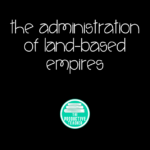You have already learned about the specifics of each of the major trade routes between 1200 and 1450, these slides will give you an overview of how trade changed the world. It includes basic information about the Silk Roads, the Indian Ocean Trade Routes, and the Trans-Saharan Trade Routes. There is also a little information on the trade in the Americas. Check out the Google Slides!
WHY DID TRADE INCREASE?
Trade between 1200 and 1450 increased for various reasons, leading to the growth of interregional and international commerce:
Improved Transportation: Technological advancements in transportation played a pivotal role. The use of caravanserais, which provided a safe haven for travelers and merchants along trade routes, facilitated long-distance trade. This allowed goods to be transported more efficiently and securely.
Commercial Innovations: The development of innovative financial instruments and systems of credit encouraged trade. Bills of exchange and promissory notes, for instance, made it easier to conduct business across vast distances without the need for physical currency transfers.
Emergence of Money Economies: The establishment of standardized currencies, such as paper money and metal coins, promoted trade by providing a widely accepted medium of exchange. This allowed merchants to more easily conduct transactions with traders from different regions.
Infrastructure Development: The expansion and maintenance of trade routes, including land-based routes like the Silk Roads and sea routes like the Indian Ocean trade network, played a crucial role. These routes were supported by a network of roads, bridges, ports, and navigational aids.
Demand for Luxury Goods: The increasing demand for luxury items, including silk, spices, precious metals, and ceramics, motivated merchants to seek new trade opportunities. The desire for these goods drove interregional and international trade.
Technological Advances: Technological innovations, such as the introduction of more efficient ships and navigational tools, improved the ability to conduct overseas trade. These advancements expanded the geographical scope of trade networks.
Political Stability: Political stability and the absence of large-scale invasions in certain regions facilitated trade. Areas with strong and secure governance were more attractive to merchants and traders.
Cultural Exchange: The Silk Roads, for example, were not just conduits for goods but also for cultural and intellectual exchange. This encouraged trade as people from different regions became more interconnected and open to new ideas and products.
Major Trade Routes
Between 1200 and 1450, several major trade routes crisscrossed the continents, connecting diverse regions and fostering a significant exchange of goods, ideas, and cultures. The Silk Roads served as a vital overland trade network, connecting China with the Mediterranean and Europe, facilitating the exchange of silk, spices, precious metals, and knowledge. The Indian Ocean trade routes linked the Indian subcontinent, Southeast Asia, the Middle East, and the coast of East Africa, carrying spices, textiles, and other commodities. In West Africa, the Trans-Saharan trade routes enabled the movement of gold, salt, and other valuables. Furthermore, the Mesoamerican trade networks in the Americas allowed the exchange of goods such as cacao, textiles, and feathers among the Aztec and Maya civilizations. These trade routes were essential conduits of global interaction, contributing to the diffusion of technology, culture, and economic prosperity during this period.
Cities Along the Silk Road
The Silk Road, a vast network of interconnected trade routes, gave rise to several prominent trading cities between 1200 and 1450. One of the most renowned cities along the land-based Silk Road was Samarkand in Central Asia, a hub for the exchange of goods, culture, and knowledge. In China, Xi’an, an ancient capital, served as a crucial starting point for the Silk Road, while Dunhuang acted as a gateway to the western regions. Moving west, Bukhara and Tashkent in modern-day Uzbekistan were prominent trading posts. Along the maritime Silk Road, Calicut and Malacca in the Indian Ocean basin were thriving trade cities, welcoming ships from different parts of the world. Venice and Genoa in Europe were essential destinations for merchants involved in Silk Road trade, as they acted as intermediaries between the East and West. These trading cities played a vital role in connecting the vast expanse of the Silk Road and facilitating the exchange of goods and ideas across continents.
Cities Along the Indian Ocean Trading Routes
The Indian Ocean trading routes, between 1200 and 1450, gave rise to several bustling cities that served as pivotal hubs for commerce, cultural exchange, and innovation. Calicut, on the southwestern coast of India, was a major trading port, welcoming vessels from the Middle East, Southeast Asia, and even as far as China. It thrived on the spice trade, making it a significant destination for merchants. Further east, Malacca, strategically located along the Strait of Malacca, became a vital crossroads for merchants from different corners of the Indian Ocean basin. It was a center for the spice and precious metal trade. In East Africa, Kilwa and Sofala were prominent trading cities, acting as intermediaries in the exchange of African resources, such as gold, ivory, and exotic goods from the interior, with Middle Eastern and Asian traders. These cities flourished due to their roles in facilitating trade and cultural interactions across the expansive Indian Ocean region.
Cities Along the Trans-Saharan Trading Routes
Between 1200 and 1450, the Trans-Saharan trading routes facilitated the growth of several significant cities in North and West Africa. One of the key cities was Timbuktu, located in present-day Mali. It became a renowned center for trade, scholarship, and the exchange of goods like gold, salt, and manuscripts. Further west, Gao, also in Mali, served as a vital trading hub along the Niger River. In North Africa, Cairo, Egypt, became a thriving metropolis, connecting the Mediterranean with Sub-Saharan Africa and the Red Sea. To the northwest, Fez in Morocco prospered as a trade and cultural center, and in the Sahel region, Kano in Nigeria was known for its role in the Trans-Saharan trade, particularly in textiles and other commodities. These cities played a crucial role in the exchange of goods, ideas, and cultures between the African Sahel, North Africa, and beyond during this period.
Be sure to check out the tables that show what each group traded in the Google Slides.
Cultural Changes
The period between 1200 and 1450 was marked by a significant expansion of trade networks, connecting diverse regions of the world. This increased interregional trade had profound cultural consequences. As goods, ideas, and people flowed along trade routes, cultures came into contact and exchanged knowledge, customs, and beliefs.
Exchange of Knowledge: Trade facilitated the exchange of knowledge and technology. For example, the transfer of mathematical and astronomical knowledge from the Islamic world to Europe played a crucial role in the Renaissance. Similarly, Chinese inventions like papermaking, printing, and gunpowder gradually spread to other parts of the world.
Cultural Hybridization: Regions where trade routes intersected often became melting pots of cultures. Cities like Baghdad, Constantinople, and Timbuktu served as crossroads of cultures, where people of diverse backgrounds interacted, leading to the blending of traditions and the creation of new cultural practices.
Religious Diffusion: Trade routes acted as conduits for the spread of religious beliefs. For instance, Islam’s expansion into West Africa was significantly facilitated by trade, resulting in the conversion of many African societies. Buddhism also spread along trade routes to Southeast Asia.
Artistic and Architectural Exchange: Artistic styles and architectural influences were exchanged across regions. The fusion of Gothic and Islamic architectural elements in Spain’s Alhambra Palace is one such example of cross-cultural artistic exchange.
Language and Literature: Trade encouraged the exchange of languages and literature. The travels of Marco Polo and Ibn Battuta, for instance, led to the recording of their journeys, which provided valuable insights into distant lands.
Culinary Exchange: The movement of goods and spices along trade routes revolutionized culinary practices. For example, the introduction of spices from the East greatly impacted the cuisine of Europe.
Environmental Changes
The era between 1200 and 1450 brought about a surge in global trade, and while it had many positive outcomes, it also had significant environmental consequences.
Deforestation: To meet the growing demand for timber, particularly for shipbuilding, and to clear land for agriculture, including growing bananas introduced from Indonesia, extensive deforestation occurred in various regions. This not only disrupted local ecosystems but also contributed to soil erosion and loss of biodiversity.
Mining and Resource Extraction: The quest for valuable resources such as precious metals and gemstones led to increased mining activities. This not only scarred the landscape but also had detrimental impacts on water quality as mining operations often involved the use of toxic chemicals.
Agricultural Changes: The expansion of trade routes resulted in the exchange of crops and agricultural practices. While this led to increased agricultural productivity, such as when Champa Rice arrived in China, it also introduced non-native species to new regions, sometimes resulting in invasive species that disrupted local ecosystems.
Water Management: The need for reliable water sources along trade routes prompted the construction of aqueducts, canals, and other water management systems. These structures sometimes led to the diversion of rivers and affected local hydrology.
Urbanization and Pollution: The growth of trading cities led to urbanization, which often resulted in increased pollution and waste. Waste disposal and sanitation systems were inadequate, leading to contamination of water sources and air pollution.
Spread of Diseases: The movement of people and goods along trade routes facilitated the spread of diseases. Pandemics like the Black Death, which decimated populations, had far-reaching environmental impacts as well, as abandoned agricultural fields reverted to forests.
Habitat Loss: As trade routes expanded, natural habitats were encroached upon. Wetlands, forests, and grasslands were transformed into agricultural and urban areas, leading to the loss of critical habitats for wildlife.
Would you prefer to watch a video about the Networks of Exchange?
Want to get back to the overview of the 1200 – 1450 CE section?








Leave a Reply